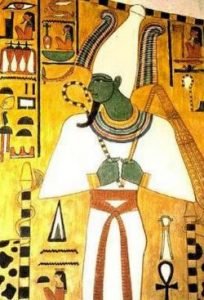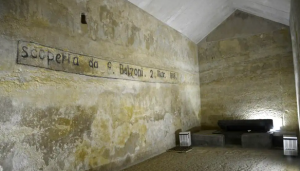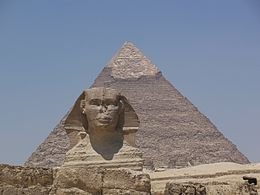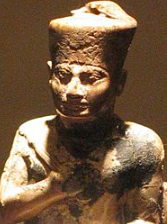Khafre: Origin Story, Reign, Khafre Pyramid & Accomplishments
One simply cannot discuss the Old Kingdom of ancient Egypt without mentioning Pharaoh Khafre, who was one of the great pyramid builders in ancient Egyptian history. Did you also know that Khafre was the son of King Khufu, the Egyptian monarch who built the largest pyramid of Giza?
What else was King Khafre most famous for?
WHE presents everything that you need to know about Pharaoh Khafre, including his origin story, major accomplishments and contributions.
Khafre: Quick Facts

Khafre – ancient Egyptian pharaoh of the Fourth Dynasty of the Old Kingdom (i.e. the Pyramid Age of ancient Egypt). Image: Alabaster statue of Khafre, probably from Memphis, now in the Egyptian Museum at Cairo.
Lifespan: c. 2600 BC – c. 2551 BC
Other names: Khafra, Chephren, Khaefre
Reign: c. 2575 BC – c. 2551 BC
Dynasty: Dynasty IV
Father: Khufu
Chief wife: Khmaerernebti I (Khamerernebty I)
Most known for: Constructing the Khafre Pyramid; fourth ruler of the 4th dynasty
Predecessor: Djedefre
Successor: Menkaure
Khafre Enthroned

Made from a hard rock called diorite, Khafre Enthroned is a funerary statue of 4th Dynasty pharaoh Khafre. The Pharaoh is shown as a well-built and muscular man. Such depictions of ancient Egypt monarchs were very common because the pharaohs were seen as the manifestations of the gods.
Currently located in the Egyptian Museum in Cairo, Khafre Enthroned funerary statue measures at five foot six. It was discovered in the chamber room (the serdab) in the Valley Temple of Khafre.
Khafre Enthroned shows Old Kingdom pharaoh Khafre seated in a lion-decorated throne. Made from the rock diorite, the statue is considered one of the most well-known sculptures from the Old Kingdom era.
Diorite is a very hard stone that contains anorthosite gneiss. Owing to those properties, the stone does not easily lend itself to carving. Khafre, who was aware of the properties of the stone, used it in making his statue because of the stone’s longevity.
A god-king
King Khafre, like many ancient Egyptian pharaohs, considered himself the ruler of the land of the living. A god-king, he and his subjects believed that upon death, the king would become the ruler of the afterlife as well. And what better way to communicate the permanence of rulership and divine authority than to use a very hard stone that could better withstand the ravages of time.
Royal artists and sculptors depicted Khafre in an athletic physique in order to communicate his divine status and lordship over the land of the living and later king in the afterlife.
Read more: List of Egyptian Gods and Goddesses
Lord of both Upper and Lower Egypt
The statue shows Khafre wearing a nemes headdress with the uraeus (i.e. a cobra emblem) symbol. The uraeus, which was an important symbol of Wadjet, the protective patron goddess of Lower Egypt, is believed to have been used by Egyptian monarchs to represent divine sovereignty and royalty.
Having symbols of Horus and Wadjet was a way of communicating Khafre’s divine authority over the two lands – Upper and Lower Egypt respectively.
Association with Osiris
The green color properties of the stone used in making the statue has been interpreted as Khafre’s way of communicating the belief that he was bound to be rejuvenated (reborn) in the afterlife. The pharaoh was most likely referencing his association with Osiris, the green-skinned god of the afterlife and agriculture.

Osiris
Other important meanings derived from the Khafre Enthroned statue
Carved from a cube-shaped stone block of diorite, Khafre Enthroned shows the King in a kilt around his waist. The kilt was a popular attire in ancient Egypt, especially for male royals.
The statue also shows him with a royal artificial beard. Ancient Egyptians saw the beard as a symbol of the pharaoh’s power. This explains why female pharaohs like Hatshepsut wore the royal beard.
To demonstrate Khafre’s kingship over the two unified lands of Egypt – i.e. Lower and Upper Egypt – Khafre’s throne was decorated with symbols of Egypt’s unification, including the papyrus plant, lions and lotus. The lotus plant was often associated with Upper Egypt, while the papyrus plant often represented Lower Egypt.
Khafre Enthroned statue also shows a falcon, which represents the falcon-headed god Horus, wrapping its wings around Khafre’s neck. Aside from this communicating the pharaoh’s association with the god Horus, this image projects the divine protection the pharaoh received from the gods, particularly Horus. As a matter of fact, Egyptians pharaohs were seen as the earthly manifestations of Horus, an Egyptian deity who was predominantly worshiped in Upper Egypt.
Finally, the engravings of nine archery bows on the throne symbolize Khafre’s military conquest over foreign nations and foes.
Did you know: Upon death, the pharaoh rose to become the divine embodiment of Osiris, the Egyptian god of the afterlife and agriculture?
Khafre’s ka
Ancient Egyptians believed that the funeral statue of Khafre served as the resting place for the ka of the pharaoh. An element of the soul, the ka was believed to be the vital essence that stayed with the individual throughout his/her life. This made the ka very significant in ancient Egyptian religion.
Upon death, the ka (i.e. spirit) flew out of the body and entered the afterlife. Regardless, the ancient Egyptians believed that ka still had to have a physical container to dwell in so as to enable the dead person’s identity to perpetuate for eternity.
Read more: The significance of Ka and other important parts of the soul in ancient Egyptian religion
Reign and major achievements
It’s commonly held that Khafre’s reign over Egypt spanned from around 2554 BC to 2530 BC. The generally accepted view in the archeological community is that Khafre succeeded his half-brother Djedefre, who ruled for about eight years.
Like his early life, not much is known about the reign of Khafre other than the fact that he built the second largest pyramid on the Giza plateau.
Some scholars opine that his reign, like that of his father’s, was a very a successful one. Judging by the sheer number of remnants of Khafre’s statues, it’s been stated that his reign saw the advancement of sculpting and other artistic works.
His use of a very valuable and hard rock as diorite in his funerary statue (i.e. Khafre Enthroned) was intended to communicate the wealth and power that he wielded. For example, some of the rocks that he used had to be transported from quarries several hundreds of miles down the Nile River.
Artisans in the Pharaoh’s era pushed the boundaries of their technical abilities in not just the usage of diorite but other materials like grewacke, quartzite and limestone. Those technical advancements made during Khafre’s reign would go on to have lasting impact on the Old Kingdom era and beyond.
How long did Khafre reign?
The Turin King List fails to provide the duration of Khafre’s reign; however, Manetho states that Khafre reigned for about 66 years. This was undoubtedly an exaggeration as many in the archeological community today believe that Khafre reigned for about two and the half decades.
Ancient Greek philosophers and historians Diodorus and Herodotus opined that Khafre succeeded his father Khufu (Greek: Kheops or Cheops) and then ruled Egypt for 56 years.
Khafre’s numerous statues
In 1858, archeologist Auguste Mariette discovered nine statues of Khafre during excavation works in a pit in vicinity of Khafre’s Valley Temple. The diorite statue of Khafre Enthroned was also part of Mariette’s spectacular discoveries.
Among all the Old Kingdom monarchs, Khafre is said to have the most number of statues. It’s been estimated that he placed several hundreds of statues of himself in his pyramid complex at Giza.
Khafre Enthroned – a funeral statue of Khafre – which was found in his valley temple, was constructed from diorite. The rock was transported from faraway quarries in the dessert of Nubia (today’s Sudan). Having been ravaged by years of tomb bandits, many of the statues of Khafre that were discovered in the valley temple were headless.
Pyramid of Khafre – the second largest in the Giza Necropolis

Khafre’s pyramid is one of the three Great Pyramids of Giza. Image: Khafre’s Pyramid (second) in the Giza Plateau
Khafre followed in his father’s footstep and built a magnificent pyramid on the Giza Plateau, which is on the outskirts of what is today Cairo, Egypt. The plateau, which is also known as the Giza necropolis or the Giza pyramid complex, is home to two other great pyramids – Khufu’s pyramid and Menkaure’s pyramid.
Similar to Khufu’s pyramid, the Pyramid of Khafre obviously consumed quite a lot of resources and time of the pharaoh.
Out of reverence to his father Khufu, Khafre did not want his pyramid to be as tall as his father’s tomb (i.e. the Great Pyramid of Khufu).
It is also likely that Khafre purposely built his pyramid on a slightly higher ground in order to make his pyramid look taller than his father’s.
Ancient Egyptians believed that the pyramid allowed the king to make his way to the heavens and become Osiris in the afterlife.

Entrances into Khafre’s Pyramid on the Giza Necropolis
To the ancient Egyptians, Khafre’s pyramid was known as Wer(en)-Khafre (“Khafre is Great”). And just beside the pyramid sits a kind of annex pyramid called GII. Based on some ancient texts that were found in the area, it’s likely that one of the pharaoh’s sons was buried there.
After tomb raiders pillaged the tomb of Khafre in the First Intermediate Period, King Ramesses II (also known as Ramesses the Great) of the 19th Dynasty used a number of the stones and sculptures from Khafre’s pyramid complex in building his magnificent temple in Heliopolis.
It’s also been theorized that 19th Dynasty monarch Ramses II had many of Khafre’s life-size statues in the mortuary temple removed and thereafter recycled them.
Properties of Khafre’s pyramid

Built in the same area as his father’s pyramid (i.e. Khufu’s pyramid), Khafre’s pyramid stands at around 470 ft., which is about 30 ft. shorter than Khufu’s pyramid. Image: Khafre’s pyramid in the Giza necropolis
Originally, the Pyramid of Khafre stood at around 471 ft. (143 m); however, due to the ravages of time, it now stands at around 452 ft. (138 m). At that height, Khafre’s pyramid is 30 ft. shorter than his father’s pyramid – Khufu’s Pyramid, which measures at 481 ft. (146 m). Khafre’s pyramid is therefore the second largest of the three Great Pyramids of Giza.
The length of the base of the pyramid is around 705 ft (215 meters). Constructed of limestone blocks, Khafre’s pyramid has a slope of an angle of 53° 13’, making it steeper than Khufu’s pyramid.
Did you know: Some of the limestone blocks used in constructing Khafre’s pyramid weigh over 2 tons?
Khafre’s burial chamber
The mummy of Khafre was sealed in a burial chamber of the Pyramid. There are two entrances that lead to the burial chamber. Those entrances are located on the north face. The burial chamber of Khafre is almost centrally located. Cut from the rock, the chamber spans about 14.15 by 5 meters.
Khafre’s sarcophagus was carved out of a solid block of granite. The plane polished red granite sarcophagus was slightly sunk in the floor.
On March 2, 1818, archeologist Giovani Belzoni made an entry into the burial chamber in the pyramid. He was disappointed to find out that people had entered before him. There were only animal bones in the chamber. The chamber had suffered from many tomb raids of the past.

Belzoni wrote his name and date of entry on the south wall above the entrance into the burial chamber of Khafre. Image: Burial chamber of Khafre
Also in the pyramid is a subsidiary chamber, whose purpose remains unknown to this day. It is possible that the chamber was used to store offerings, burial tools, or a chamber for the storage of the ka statue.
Khafre’s Pyramid Complex
There is a satellite pyramid on the south side of Khafre’s Pyramid complex. Almost nothing of the pyramid survived to this day, other than blocks and the outline of the foundation.
In the same vicinity as Khafre’s pyramid is his valley temple, which was sited closer to the Nile River. There is a long causeway that connects Khafre’s pyramid to his valley temple. The valley temple of Khafre was made from very large blocks of granite.
Some of the frequently mentioned Egyptian gods and goddesses in Khafre’s Valley Temple are Bubastis and Hathor. The falcon-headed god Horus also features prominently in the buildings constructed by Khafre.
Khafre built his mortuary temple close to his pyramid. The mortuary temple is similar to the valley temple. Connecting the Valley Temple to the Mortuary Temple is a 540-yard (494 meters) causeway.
The Mortuary temple of Khafre is believed to have stored offerings made to the dead pharaoh and other ceremonies. Like Khafre’s Valley Temple, the mortuary temple is largely in ruins. It was in the mortuary temple that many life-size statues of Khafre was found. Unbeknownst to many people, some of the blocks used in the mortuary temple weigh more than 400 tons.
Did you know: Ancient Egyptians associated the west of the Nile River with decay and death, explaining why the Giza Necropolis was located on the west of the Nile?
The Great Sphinx of Giza and its resemblance to Khafre

The Great Sphinx was built just close to the causeway that links Khafre’s Pyramid and Khafre’s valley temple. Thus the pyramid of Khafre is in the background of the Great Sphinx.
Also found in Khafre’s Pyramid Complex is the Great Sphinx of Giza. A sphinx is a mythological creature with a human head and a lion’s body. Images and sculptures of sphinx was a common feature in not just ancient Egypt but also ancient Greece.
The facial features on the Great Sphinx bears some bit of resemblance to Khafre, making some Egyptologists and scholars to credit Khafre with building the Great Sphinx.
The Great Sphinx of Giza shows creature with the a pharaoh’s head and cat body. The colossal structure is found west of Khafre’s pyramid. Archeologists have interpreted as communicating the power of the lion and the creativity of man.
There have been scholars that reject the claim that the Great Sphinx was built during the era of Khafre. Those scholars state that the Great Sphinx was built long before Khafre became king.
On the contrary, the slight resemblance between what is left of the face on the Great Sphinx and Khafre’s statues has led some modern Egyptologists and archeologists to maintain that the Great Sphinx was built during the reign of Khafre. There is also a striking resemblance between the royal linen headdress on Khafre’s statue and the one on the Sphinx.
Did you know?
- Built about 4,500 years ago, the Pyramid of Khafre still has some bit of the original limestone casing at the apex of the structure.
- The pyramid built by Khafre was once considered the tallest on the Giza plateau. However, we know today that it is slightly shorter than Khufu’s pyramid.
- Many of Khafre’s family relatives did not received the kind of splendid; instead they were buried in a simple tombs.
Family

Pharaoh Khufu was the father of Egyptian Pharaohs Djedefre and Khafre. Image:- Ivory idol of Pharaoh Khufu in detail
Ancient Egyptian king Khafre was the son of King Khufu and his wife Queen Meritites. According to some scholars and archeologists however, Khafre’s mother was instead the son of Henutsen, who was herself Khufu’s second or third wife.
Archeologists that put Queen Meritites I as the mother of Khafre cite an ancient inscription that shows Khafre heaping praises on Meritites I.
Khafre’s numerous wives and children

Meresankh III – Khafre’s niece and wife
As it was common with many ancient Egyptian pharaohs, King Khafre took for himself several wives, including his chief consort Queen Meresankh III. The queen was said to be the daughter of Prince Kawab and Queen Hetpheres II, both of who were the children of Pharaoh Khufu. What this means is that Khafre married the granddaughter of his father.
Other notable wives of Khafre were Khamerenebty I, Persenet, Hekenuhedjet, and Persenet.
By queen Khamerernebty I, Khafre gave birth to Prince Menkaure, who later succeeded him to the throne. The royal couple also gave birth to to Khamerernebty II, who married her brother Menkaure.
By Queen Meresankh III, Khafre fathered a number of sons, including Duaenre, Khentetka, Nebemakhet, and Niuserre. He also fathered a daughter called Shepsetkau.
Khafre’s successor – Menkaure

Menkaure was Khafre’s son and succeeded to the throne following the death of Khafre
Having reigned from around 2554 BC to 2530 BC, Khafre was succeeded to the throne by his son Menkaure (Mykerinos in Greek). However, according to ancient Egyptian scholar and historian Manetho, Khafre was succeeded by King Bikheris, who was probably the son of Pharaoh Djedefre.
Read More:
- 10 Most Famous Religious Festivals in Ancient Egypt
- 12 Greatest Cities of Ancient Egypt
- 10 Notable Pharaohs of ancient Egypt
Other notable Khafre facts

Cartouche name Pharaoh Khafre in the Abydos King List. Pharaoh Khafre was one of the numerous sons of Pharaoh Khufu
- About 2,000 years after the reign of Khafre, Herodotus – a 5th century BC Greek philosopher and historian – wrote about the life and reign of Khafre. Much of what we know about Khafre comes from Herodotus. Ancient Egyptian historian Manetho also presents a bit of information about Khafre. According to Manetho, Khafre was succeeded to the throne by King Bikheris.
- The Greek name for Pharaoh Khafre is Chephren or Khephren.
- In the accounts of Herodotus and Diodorus, Khafre, like his father Khufu, was a cruel leader, a despot. According to those scholars, Egypt was saved by the ascension of Menkaure to the throne following the death of Khafre. Unlike Khafre and Khufu, Menkaure was a generous ruler, according to Herodotus.
- Ancient Egyptian pharaohs often took an epithet that archeologists and scholars today term as the Horus name. In Khafre’s case, his Horus name was Wesser-ib, which means “Horus, who is strong of heart”. His nomen was “Horus, Appearing like Re”, while his Nebty name was “The one who is strong with the Two Ladies”. In Egyptian mythology, Re (or Ra) was the sun god famous for riding his sun barge every day from the underworld in order to bring daylight to the land of Egypt.



























